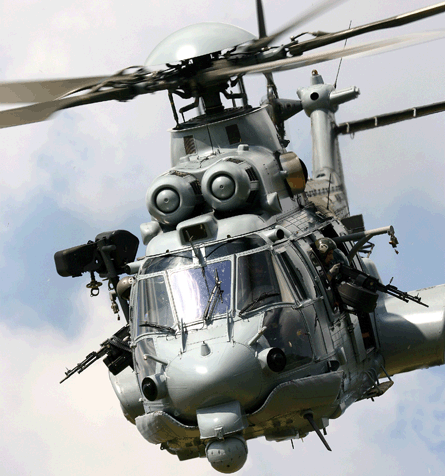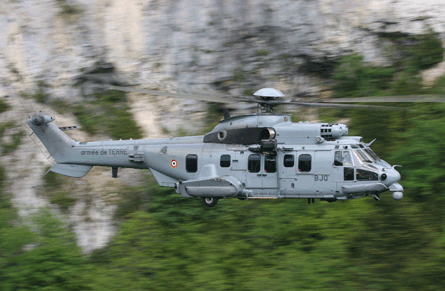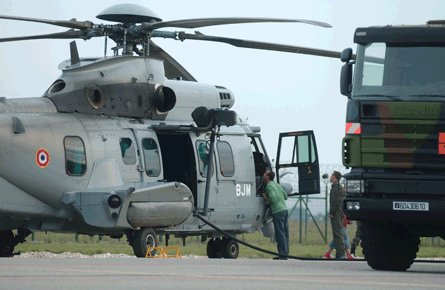Rarely does a new aircraft type undergo a literal baptism of fire quite like the one that Eurocopter's EC725 Caracal has endured in Afghanistan since its deployment in November 2006.
In the 12 months ending April this year the three deployed aircraft totted up just short of 800h flying on more than 600 operational missions in the country including the Uzbeen Valley ambush last August that left 10 French troops dead.
In the Uzbeen mission two helicopters flew uninterrupted for more than 14h each day and night, under fire, to extract the fatalities and 23 injured. It provided one of the most severe tests of an aircraft that is being hailed by its crews as an enormous in-service success both in-theatre and at home.
Primary operator of the type, and leading the combined air force/army special forces Afghan deployment, is the air force's 1/67 Pyrenees squadron headquartered at the large Cazaux base in south-west France. Six Caracals are in service, gradually replacing the Eurocopter SA330 Puma, and three serve alongside Aerospatiale Gazelle scouts in Afghanistan.
 |
|---|
© Eurocopter |
Deputy squadron commander, Lt Col Olivier Celo, who will take over command in September, says: "This is a really fantastic helicopter."
Pilots on the type praise in particular the forward-looking infrared (FLIR) system and the highly capable autopilot, or automatic flight control system (AFCS). Combining the two systems, plus the full-authority digital electronic control for the engines has produced a machine capable of extremely high performance at low level with reduced workload.
Lt Col Arnaud Cazala of the French special forces DAOS also praises the combined laser, radar and missile-warning systems, saying: "The most important thing is that they are coupled with automatic chaff and flares. The system knows the best moment to deploy chaff and flares. It's the only aircraft we have in French army aviation with such a device."
HUGE GAIN
Maj Franck Arnaudon, who flew on the Uzbeen mission, says: "This is a huge gain for us in terms of the human machine interface compared to the Puma from the 1960s. You can change the screens - for example to fly with the map on the main screen most of the time.
"And you just have a single red line to obey [in selecting power] because the system works out whether the main gearbox or the engine is at the limit."
He describes how the AFCS' 1m (3ft) accuracy over land and sea permits automatic landing in brown-out conditions aided by the "flight engineer" guiding the aircraft from the open door in the rear cabin. An envelope protection function also provides an automatic fly-away function in the event of engine failure. The same automation means that pilots "don't touch the pedals" in turns of less than 60° bank angle.
One result of these new capabilities is that the aircraft routinely operates with just the two pilots, with one behaving as a systems operator, rather than with the flight engineer/gunner in the nominal crew. Another is that the qualification period for pilots to fly the primary combat search and rescue (CSAR) mission has come down to 60h from 90h.
 |
|---|
© Eurocopter |
Arnaudon relates a medevac mission flown in a sandstorm with 1,000m visibility that could not be flown with night-vision goggles. He says that once airborne, the crew was doubtful that it could be continued but, using the FLIR image, AFCS and flight management system for navigation, the pilot quickly became confident that it could be completed.
"We considered turning back and going home, but the pilot in the left-hand seat could see even though nobody else could. We were quite confident that there was no enemy threat because nobody could see us."
The mission, flown as a two-ship formation using air-to-air Tacan, resulted in three civilians being successfully recovered.
Air force engineers are also pleased with the Turbomeca Makila-powered twin-engine type's performance, recording a reliability rate in excess of 90% and now averaging 95%.
In fact a major problem for the French when they were first deployed to NATO in Afghanistan was in educating the local commanders on their capabilities.
Arnaudon says: "For six months we were meeting the people responsible for CSAR and we presented our capabilities in crews, They wanted to be sure that the crews were qualified and now people have a very good idea of what we can do. Previously it was very difficult."
Incidents like Uzbeen, and the earlier recovery by two aircraft of the crew of a crashed Italian Agusta Bell AB212 at a difficult mountain location helped establish the Caracal detachment's reputation.
Celo says a key philosophical difference between the French way of working and that of the US Sikorsky HH-60 units is the former's belief in mixing roles so that when the Caracal is not on CSAR/medevac standby it is routinely used for tactical transport.
He explains: "We don't ground the aircraft in order to stay on alert and we mix the missions while we are on duty. The US don't have that concept.
"If I keep people on ground alert then they might only fly 85 missions in two years. Their concentration and motivation goes down. But our people know the theatre better and they do the medevac work better. They know the theatre by heart. We get given the co-ordinates and we know there is a little village there or whatever.
"Also it gives more confidence to the ground troops because we are flying with them all the time. The guys who were killed at Uzbeen we had been flying with the previous day."
He reflects: "For us it was a terrific experience. We obtained a lot of experience from that night. But I would have preferred never to fly that mission because we lost 10 soldiers."
The policy can have interesting consequences, however. Celo relates how the squadron was at one point flying the Afghan minister of defence to inspect a forward operating base. "Then we got a medevac order in the air and we explained to him that he was no longer the priority. But in fact he said he wanted to stay on and he flew with us from the base to the hospital."
 |
|---|
© Eurocopter |
Managing the detachment, while also ensuring the squadron fulfils its peacetime roles in France and elsewhere, is complex for Celo, as it is today for his NATO equivalents throughout Europe and the USA.
Air force crews currently deploy to Afghanistan for two months and Celo says there has been pressure on the air force to deploy crews for longer, which he is resisting.
"Soldiers on the ground now stay for almost six months. There are ideas to do the same with the air force. And the army guys who fly Caracal there want to stay only two months. But I think it will stay the same," he says.
"We consider that more than two months in theatre is dangerous. People get some particular habits there. They don't prepare some flights some well. Actually that started to occur after three to four months. They need to come back to France for one month for peacetime duties on flight planning and see their families."
Part of the concern is that the deployed crews do not work with the fighter squadrons that are normally the focus of their CSAR duty. Arnaudon explains: "When we are Afghanistan we don't fly with a lot of fighters so all the procedures that we use the rest of the time we don't use there, and so it is important to come back and practise the skills."
He admits also that the duty is tough, noting: "We were only a few pilots there, so you are on alert almost every day. You can't leave the base, and you get tired."
Once qualified on the Caracal, crews no longer fly the Puma and there is no such thing as dual-qualification. Celo concedes however that as the Puma fleet dwindles in future that policy may have to be modified. Five more Caracals are due to be supplied this year.
Despite the constantly expressed satisfaction with the Caracal, the crews have their own wishlist of improvements and work is under way to address some of that.
ASKING FOR MORE
Celo admits operators are never satisfied with their equipment, saying: "As a pilot I always ask for more. We reached the limit of the Caracal because we put more commandoes and equipment in the aircraft than we imagined, but if Eurocopter gave me 1t more then within two months I would ask for another tonne. If I had the money and so on then I would probably ask Eurocopter for 2t more."
More realistically the squadron is looking for improvements to the FLIR and enhanced self-protection armament.
Celo says: "At the moment you cannot assign the camera to the target so you have to fly and do it yourself and this we would like to change. Also we cannot extract the co-ordinates of the target from it, which we have also asked for."
The Caracal is currently equipped with up to two 7.62mm MAG58 guns, used to keep the enemy's head down while arriving and departing hostile areas.
Celo says: "We have asked for study of stronger armament, like 20mm or 12.7mm." Arnaudon suggests that the current pods on the Eurocopter Cougar transport "could easily be used".
Improved communications are almost certain in the near future - adding encrypted UHF, satellite communications, and compatibility with the increasingly used Iridium satellite network.
The squadron itself would like to have a robust aerial refuelling capability, but admits that it would be difficult to keep pilots current since the French tanker fleet has not developed a capability for helicopters.
A handful of pilots have refuelled from Italian tankers instead, but Arnaudon notes that a more extensive capability would be "very useful". He points out that when the squadron deployed to Lebanon in an early mission to extract French citizens it had to route Cazaux-Corsica-Italy-Crete to be in place.
The unit is less keen about another proposed role which is being tried in Afghanistan - airborne forward air control (FAC.) "I'm not all that optimistic about doing airborne FAC," says Celo. "To do that you generally have to keep the target in sight, which means you are in the sight of the enemy."
- All the latest news, images and video from the Paris Air Show
Source: Flight Daily News



















